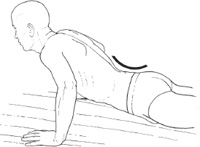The Basic Push-up
When we do a push-up, the only parts of the body that touch the floor are the toes and the palms.
We try not to let the lower back sag. We also try not to bend at the hip (sticking the butt out).
The exercise consists of bending and then straightening the arms while keeping the body in a plank position.



We start by finding a balance between our hands and the feet, with our legs and trunk between the areas of support.
When our muscles are not well developed, the spine tends to move into a big arch in plank position and the pelvis into anteversion. The abdominals are forced to contract to prevent these two actions:
- They keep the spine from arching.
- They also keep the pelvis aligned.
They work in a static or isometric contraction.
The hips, knees, and ankles tend to bend. To prevent these areas from flexing, we are forced to contract the extensors in all of these areas at the same time.
The belly, which is now facing downward, tends to stick out. We must contract the abdominals in “visceral” mode to keep the belly pulled in.
During the push-up itself, the elbows flex and extend, which calls on the extensors of the elbows. They work to extend the arms when we are pressing up and to brake the flexion when we are lowering ourselves toward the floor.

When we are new to push-ups the spine tends to arch; hips, knees, and ankles bend; and the belly tends to protrude in plank position.
When we do push-ups, the abdominals work statically, in other words, without any movement of the trunk. If we can keep the pelvis stable, the exercise, unlike crunches, can be powerful without endangering the skeleton. Push-ups can, however, put excessive pressure on the wrists if the position is held too long. In addition, the work of the abdominals is strictly isometric, which means that it does not improve blood flow in the muscles.
Push-ups Can Endanger the Perineum
On the face of it, push-ups don’t seem to affect the perineum at all. However, push-ups are tough for the upper body, and we tend to close the glottis in an effort to keep the rib cage open. If the glottis is closed and we make a pushing effort against it, this puts pressure on the perineum.

We tend to close the glottis when doing push-ups.
The pressure on the perineum can be caused:
- Directly, by the diaphragm moving toward the perineum
- Indirectly, by an ascending contraction of the abdominals sending pressure toward the glottis; if the glottis is closed, the pressure then descends toward the perineum

When we do push-ups, therefore, it’s important to keep breathing and, above all, to avoid “pushing” with the glottis closed.
Push-ups Can Endanger the Lumbar Spine
Swayback and Lumbar Disk Compression
If our abdominals aren’t strong enough, we can’t maintain our trunk in good alignment when doing push-ups. The lumbar spine then usually goes into lordosis (swayback).

At the same time, we often let our belly bulge toward the floor.
Lordosis in and of itself isn’t dangerous. However, in this position, with the abdominals in strong contraction trying to maintain the position of the trunk, the intervertebral disks are put under tremendous pressure.

The combination of lordosis and compression can overtax the lumbar disks.
Precautions
If we can’t align our trunk and legs without creating lordosis, it’s better to lift our hips a bit toward the ceiling.
This posture is not ideal for push-ups, but it is a way to adapt the exercise for beginners. Here the abdominal muscles will function more to pull in the belly than to stabilize the pelvis.

